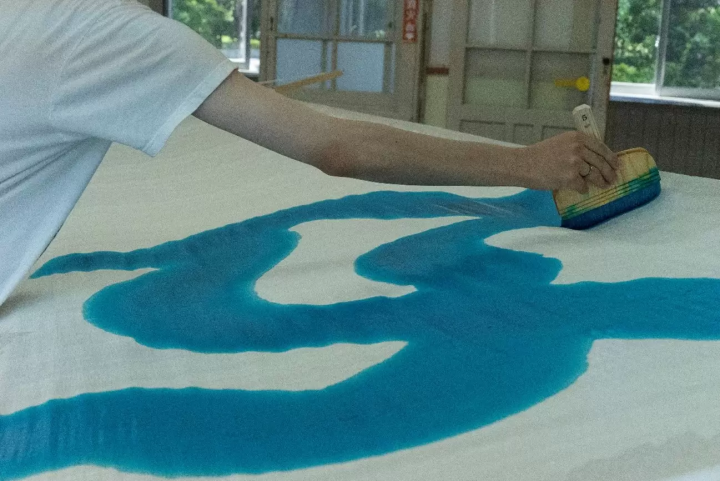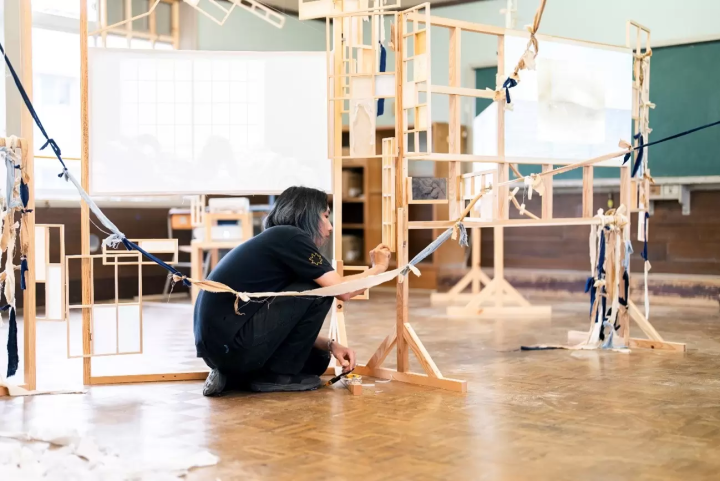NAMERIKAWA ARTIST IN RESIDENCE

Three artists will be working on their projects and holding an exhibition at the former main building of Tanaka Elementary School in Namekawa City, Toyama Prefecture.
-
Table of Contents
- What is an Artist in Residence?
- About the former Tanaka Elementary School building
- Researching materials and techniques in Toyama Prefecture
- Artist in Residence Participating Artists
- Overview of NAMERIKAWA ARTIST IN RESIDENCE
In August 2024, an artist-in-residence program was held for three young artists at the former main building of Tanaka Elementary School, a nationally designated tangible cultural property in Namekawa City, Toyama Prefecture. The aim of the program is to encourage artists from outside Toyama Prefecture to spend a medium to long period of time away from their everyday lives, to interact with different cultures and people, to try new materials and techniques, and to provide an opportunity for the participating artists to take further steps forward. Through a variety of experiences, the participants created a variety of art works, including dyeing, sculpture, and installation, over a period of about three weeks, and presented the results in the form of an exhibition in the final week.
What is an Artist in Residence?

Artist-in-Residence (AIR) is a program in which an artist stays in a specific place for a certain period of time and engages in creative activities. Through this program, it is expected that the artist will gain new inspiration and have the opportunity to come into contact with different cultures and environments, and that it will also bring new cultural value to the local community.
About the former Tanaka Elementary School building

The venue, the former main building of Tanaka Elementary School, was built in 1936 and is a historic wooden school building that has been selected as one of the "100 Best Buildings of Toyama" for its ceilings, electrical fixtures, interior woodwork, and handrails, all of which feature Renaissance, Art Deco, and geometric pattern designs.
Due to earthquake-resistance construction work, all parts of the school except the main building were demolished, but the remaining main building was registered as a national tangible cultural property in 2016. The school was also the setting for the movie "Wolf Children," and is loved by many people, from those who attended the school in the past to fans of the movie.
Researching materials and techniques in Toyama Prefecture
The research period from May to July 2024 involved visiting traditional crafts, primary industries, educational institutions, etc. in Toyama Prefecture, and preparing for production starting in August.

Inami, Nanto City / Woodcarver and Director of the General Incorporated Association Jisou Lab, Daichi Maekawa / History and techniques of Inami carving

Uozu City Kakuma / Aiya indigo dyeing shop / Indigo dyeing

Matsui Weaving Co., Ltd., Johana, Nanto City / Johana silk, Shike silk

Toyama Prefectural Himi High School, Marine Science Department / How to reuse sea urchin shells (as dye)
Artist in Residence Participating Artists

Yuuma Ishii / Kanazawa College of Art, Graduate School of Art and Crafts, Department of Crafts, Textile and Dyeing Course
I create dyed works using traditional hand-painted Yuzen techniques. In Yuzen, design and drafting are considered to be very important processes. However, in my work, I do not use the design and drafting process at all. I improvise and place resist paste on every corner of the fabric, without any drafting. After creating a pattern with the resist paste, I randomly apply dye with a face brush. The patterns that are born as my hands please are traces of my physicality.
Every day, as I carry out the intricate work of itome-nori resist dyeing, I feel my desire for texture growing. Through the sensation of moving my hands, I am confronted with my own fundamental desires and feelings. Using the act of dyeing as a starting point, I would like to approach my own feelings and inner sense of beauty and express them in my work.



"The Full Sea" dyeing / Shike silk, acid dye
The sea is full of abundance. This inspired me to dye a piece of fabric. The inspiration for this piece came from the sea at Namerikawa. I sat on the concrete bank at the water's edge and spent the whole day looking at the sea. I had heard that about 70% of the earth is covered by the sea, but when I stood in front of the vast ocean, I once again felt the total amount of water that fills this world, and its overwhelming abundance. This work incorporates two expressive techniques: pattern expression using the Yuzen thread paste resist dyeing technique, and accidental color expression through the action of water. The former artificially controls the movement of the dye, producing a precise expression as intended. The latter allows the dye, once dyed, to move freely under the influence of water, creating a generous and organic scene by chance.

Mizuki Nakazawa / Sculptor
I feel that there was an environment and history before I existed, and that I am connected to vast time and space from the moment I was born, and that my existence depends on them. From this connection, I try to express the sensual connection between myself and the environment and the accompanying uncertainty of existence as something more universal through sculpture.
At the same time, his work can be said to be an attempt to transcend the framework of the world that has been determined since birth, as a phenomenon different from reality emerges within the sculptures.



"Beyond the Horizon" Sculpture / pine, cloth, photography
"Hiding Place" Sculpture / Camphor, cloth, synthetic hair
"Connected, Separated" Sculpture / Camphor wood, cloth, synthetic hair
I often go to the old main building of Tanaka Elementary School by bicycle. As I ride through the streets of Namekawa, a large horizon spreads out, glimpsing and disappearing, as if connecting the vertical gaps that the buildings are conscious of. On the other side of the sea, a mountain range appears and disappears, higher than the horizon, and is less frequently hidden, as if it is painted over with changing brightness. It is impossible to imagine what lies beyond the view that can be seen in either case. When I look away from the distant view and look at the scene closer to me, I am attracted to the greenery of what appears to be a vacant lot, which appears quite frequently. The place, which can be called "empty," seems to be filled with a fulfilling space, and my eyes are drawn to the plants and the blank space above them. The production process of these works on display is not very different from usual. I cut wood, assemble it, carve the shape, and paste cloth and photographs on the surface. However, I was surprised at how much my works changed when I moved away from my usual base. I hope that the sense of fulfillment of the open space I felt in Namekawa is reflected in my works.

Shinji Kamijo / Tokyo University of the Arts, Graduate School of Fine Arts, Department of Inter-media Art
I sometimes find myself peering into a room in the building opposite. Looking beyond the open curtains, I notice discarded clothes and half-empty glasses. An ordinary streetscape with people coming and going. Scenes born from the accumulation of these people and their activities, and the countless stories that exist there. For me, expression is about selecting these as complex scenes and depicting a new continuity. I want to reexamine the endless time itself of the world we live in.



"The Calm Room"
Video installation / wood, washi paper, fabric, inkjet print, acrylic, multi-projection (full HD, color)
Since my grandfather passed away at the end of last year, I have had more time to think about death and aging. Among the many belongings left behind in my grandparents' house, what particularly caught my eye were the wooden frames and washi paper used to make folding screens. The wooden frames seemed like small windows through which one could see into various realities. There is also a technique for making washi paper called tsugigami, in which pieces of paper with different colors and textures are joined together to create a single piece of paper. I have used these motifs and techniques to create a multifaceted, multi-layered installation. Within it, I have projected images that symbolize sleep and the gaze of others, projecting diverse views on life and death and a sense of distance from things.
Overview of NAMERIKAWA ARTIST IN RESIDENCE
Atom Co., Ltd., the organizer of this project, is hosting the A-TOM ART AWARD, which invites works from students studying art nationwide, with the aim of nurturing young artists and revitalizing cities and regions through culture. As a prize for the award, three young artists who won the TOYAMA Award and the Epson Projection Award stayed and created their works at the former main building of Tanaka Elementary School, a registered tangible cultural property in Namekawa City, Toyama Prefecture, and exhibited their results. TOYAMATO Co., Ltd., a Toyama-based urban development company and an affiliate of our company, signed a comprehensive partnership agreement with Namekawa City, Toyama Prefecture on May 9, 2023. This project aims to help revitalize the region through interactions with local people, companies, students, etc.
Website: https://a-tomartaward.jp/
A-TOM ART AWARD Instagram @atomartaward
NAMERIKAWA ARTIST IN RESIDENCE | EXHIBITION
■Schedule◻︎Residence production: Thursday, August 1st to Friday, August 23rd, 2024
◻︎Results exhibition: August 24th (Sat) - September 1st (Sun), 2024
■ Venue Tanaka Elementary School Former Main Building 230-1 Kashimacho, Namekawa City, Toyama Prefecture
■Artist: Yuuma Ishii @ishiiyuma_ / Kanazawa College of Art, Graduate School of Fine Arts and Crafts, Department of Crafts, Textile and Dyeing Course
Mizuki Nakazawa @nakazawa_mizuki / Sculptor (at the time of receiving the award, a doctoral student in the Sculpture Research Department at the Graduate School of Fine Arts, Tokyo University of the Arts)
Shinji Kamijo @shinjikamijo / Tokyo University of the Arts, Graduate School of Fine Arts, Department of Inter-media Art
Organizer: Atom Co., Ltd.
Cooperation: TOYAMATO Corporation, Epson Sales Corporation, Plumbaum, Matsui Weaving Co., Ltd., FP Real Estate Center Co., Ltd. Sponsored by: Namekawa City
Inquiries about Hokuriku
Email address: info@toyamato.jp
Phone number: 076-471-5030
Website: https://toyamato.jp
Established by Shigeru Aoi, CEO of Atom Co., Ltd., which has a connection with Toyama, Kitanihon Shimbun, which represents Toyama, and Ayumu Ishikawa, a professional baseball player from Toyama. We are a team that connects something with Toyama and creates new businesses together with Toyama. If you define “regional revitalization” as creating a sustainable society by making use of the characteristics of each region in Japan to put a brake on the overconcentration of Tokyo, the “regional awakening” that Toyamato is aiming for is completely different. have a concept Instead of being led by the local government or government, many people with a love for Toyama will rediscover the charm of Toyama, take pride in it, and spread it around the world on their own initiative. Ultimately, the main character is “people”, and I believe that the diversity of people mixed together will enhance the appeal of Toyama.
The contents on this page may partially contain automatic translation.



























![[2026] Top 5 Strawberry Picking Spots in Tokushima, Naruto| Farms and Access Guide for January to May](https://resources.matcha-jp.com/resize/720x2000/2025/03/06-227165.webp)


